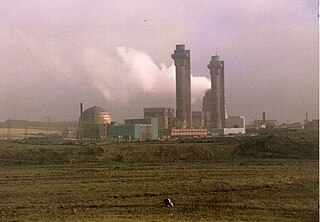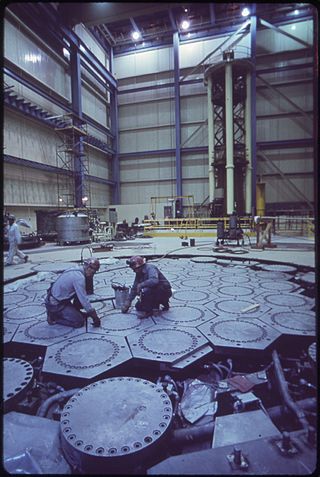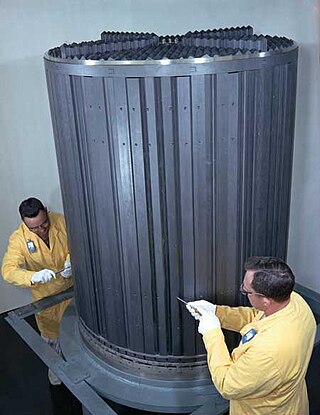
A nuclear reactor is a device used to initiate and control a fission nuclear chain reaction or nuclear fusion reactions. Nuclear reactors are used at nuclear power plants for electricity generation and in nuclear marine propulsion. Heat from nuclear fission is passed to a working fluid, which in turn runs through steam turbines. These either drive a ship's propellers or turn electrical generators' shafts. Nuclear generated steam in principle can be used for industrial process heat or for district heating. Some reactors are used to produce isotopes for medical and industrial use, or for production of weapons-grade plutonium. As of 2022, the International Atomic Energy Agency reports there are 422 nuclear power reactors and 223 nuclear research reactors in operation around the world.

A pressurized water reactor (PWR) is a type of light-water nuclear reactor. PWRs constitute the large majority of the world's nuclear power plants. In a PWR, the primary coolant (water) is pumped under high pressure to the reactor core where it is heated by the energy released by the fission of atoms. The heated, high pressure water then flows to a steam generator, where it transfers its thermal energy to lower pressure water of a secondary system where steam is generated. The steam then drives turbines, which spin an electric generator. In contrast to a boiling water reactor (BWR), pressure in the primary coolant loop prevents the water from boiling within the reactor. All light-water reactors use ordinary water as both coolant and neutron moderator. Most use anywhere from two to four vertically mounted steam generators; VVER reactors use horizontal steam generators.

The pebble-bed reactor (PBR) is a design for a graphite-moderated, gas-cooled nuclear reactor. It is a type of very-high-temperature reactor (VHTR), one of the six classes of nuclear reactors in the Generation IV initiative.

A nuclear meltdown is a severe nuclear reactor accident that results in core damage from overheating. The term nuclear meltdown is not officially defined by the International Atomic Energy Agency or by the United States Nuclear Regulatory Commission. It has been defined to mean the accidental melting of the core of a nuclear reactor, however, and is in common usage a reference to the core's either complete or partial collapse.

In nuclear engineering, a neutron moderator is a medium that reduces the speed of fast neutrons, ideally without capturing any, leaving them as thermal neutrons with only minimal (thermal) kinetic energy. These thermal neutrons are immensely more susceptible than fast neutrons to propagate a nuclear chain reaction of uranium-235 or other fissile isotope by colliding with their atomic nucleus.

The RBMK is a class of graphite-moderated nuclear power reactor designed and built by the Soviet Union. The name refers to its design where, instead of a large steel pressure vessel surrounding the entire core, the core is surrounded by a cylindrical annular steel tank inside a concrete vault and each fuel assembly is enclosed in an individual 8 cm (inner) diameter pipe. The channels also contain the coolant, and are surrounded by graphite.

A nuclear and radiation accident is defined by the International Atomic Energy Agency (IAEA) as "an event that has led to significant consequences to people, the environment or the facility. Examples include lethal effects to individuals, large radioactivity release to the environment, reactor core melt." The prime example of a "major nuclear accident" is one in which a reactor core is damaged and significant amounts of radioactive isotopes are released, such as in the Chernobyl disaster in 1986 and Fukushima nuclear disaster in 2011.

Magnox is a type of nuclear power / production reactor that was designed to run on natural uranium with graphite as the moderator and carbon dioxide gas as the heat exchange coolant. It belongs to the wider class of gas-cooled reactors. The name comes from the magnesium-aluminium alloy, used to clad the fuel rods inside the reactor. Like most other "Generation I nuclear reactors", the Magnox was designed with the dual purpose of producing electrical power and plutonium-239 for the nascent nuclear weapons programme in Britain. The name refers specifically to the United Kingdom design but is sometimes used generically to refer to any similar reactor.

A loss-of-coolant accident (LOCA) is a mode of failure for a nuclear reactor; if not managed effectively, the results of a LOCA could result in reactor core damage. Each nuclear plant's emergency core cooling system (ECCS) exists specifically to deal with a LOCA.
In nuclear engineering, the void coefficient is a number that can be used to estimate how much the reactivity of a nuclear reactor changes as voids form in the reactor moderator or coolant. Net reactivity in a reactor is the sum total of multiple contributions, of which the void coefficient is but one. Reactors in which either the moderator or the coolant is a liquid typically will have a void coefficient value that is either negative or positive. Reactors in which neither the moderator nor the coolant is a liquid will have a void coefficient value equal to zero. It is unclear how the definition of "void" coefficient applies to reactors in which the moderator/coolant is neither liquid nor gas.

The light-water reactor (LWR) is a type of thermal-neutron reactor that uses normal water, as opposed to heavy water, as both its coolant and neutron moderator; furthermore a solid form of fissile elements is used as fuel. Thermal-neutron reactors are the most common type of nuclear reactor, and light-water reactors are the most common type of thermal-neutron reactor.
Passive nuclear safety is a design approach for safety features, implemented in a nuclear reactor, that does not require any active intervention on the part of the operator or electrical/electronic feedback in order to bring the reactor to a safe shutdown state, in the event of a particular type of emergency. Such design features tend to rely on the engineering of components such that their predicted behaviour would slow down, rather than accelerate the deterioration of the reactor state; they typically take advantage of natural forces or phenomena such as gravity, buoyancy, pressure differences, conduction or natural heat convection to accomplish safety functions without requiring an active power source. Many older common reactor designs use passive safety systems to a limited extent, rather, relying on active safety systems such as diesel powered motors. Some newer reactor designs feature more passive systems; the motivation being that they are highly reliable and reduce the cost associated with the installation and maintenance of systems that would otherwise require multiple trains of equipment and redundant safety class power supplies in order to achieve the same level of reliability. However, weak driving forces that power many passive safety features can pose significant challenges to effectiveness of a passive system, particularly in the short term following an accident.

The Windscale fire of 10 October 1957 was the worst nuclear accident in the United Kingdom's history, and one of the worst in the world, ranked in severity at level 5 out of 7 on the International Nuclear Event Scale. The fire was in Unit 1 of the two-pile Windscale site on the north-west coast of England in Cumberland. The two graphite-moderated reactors, referred to at the time as "piles," had been built as part of the British post-war atomic bomb project. Windscale Pile No. 1 was operational in October 1950, followed by Pile No. 2 in June 1951.

A high-temperature gas-cooled reactor (HTGR) is a type of gas-cooled nuclear reactor which use uranium fuel and graphite moderation to produce very high reactor core output temperatures. All existing HTGR reactors use helium coolant. The reactor core can be either a "prismatic block" or a "pebble-bed" core. China Huaneng Group currently operates HTR-PM, a 250 MW HTGR power plant in Shandong province, China.

A nuclear reactor core is the portion of a nuclear reactor containing the nuclear fuel components where the nuclear reactions take place and the heat is generated. Typically, the fuel will be low-enriched uranium contained in thousands of individual fuel pins. The core also contains structural components, the means to both moderate the neutrons and control the reaction, and the means to transfer the heat from the fuel to where it is required, outside the core.

Nuclear graphite is any grade of graphite, usually synthetic graphite, manufactured for use as a moderator or reflector within a nuclear reactor. Graphite is an important material for the construction of both historical and modern nuclear reactors, due to its extreme purity and ability to withstand extremely high temperature.

The Hallam Nuclear Power Facility (HNPF) in Nebraska was a 75 MWe sodium-cooled graphite-moderated nuclear power plant built by Atomics International and operated by Consumers Public Power District of Nebraska. It was built in tandem with and co-located with a conventional coal-fired power station, the Sheldon Power Station. The facility featured a shared turbo generator that could accept steam from either heat source, and a shared control room.
A gas-cooled reactor (GCR) is a nuclear reactor that uses graphite as a neutron moderator and a gas as coolant. Although there are many other types of reactor cooled by gas, the terms GCR and to a lesser extent gas cooled reactor are particularly used to refer to this type of reactor.

The UNGG is an obsolete nuclear power reactor design developed in France. It was graphite moderated, cooled by carbon dioxide, and fueled with natural uranium metal. The first generation of French nuclear power stations were UNGGs, as was Vandellos unit 1 in Spain. Of the ten units built, all were shut down by the end of 1994, most for economic reasons due to staffing costs. A UNGG reactor is often simply referred to as an GCR in English documents.

The Windscale Piles were two air-cooled graphite-moderated nuclear reactors on the Windscale nuclear site in Cumberland on the north-west coast of England. The two reactors, referred to at the time as "piles", were built as part of the British post-war atomic bomb project and produced weapons-grade plutonium for use in nuclear weapons.

















